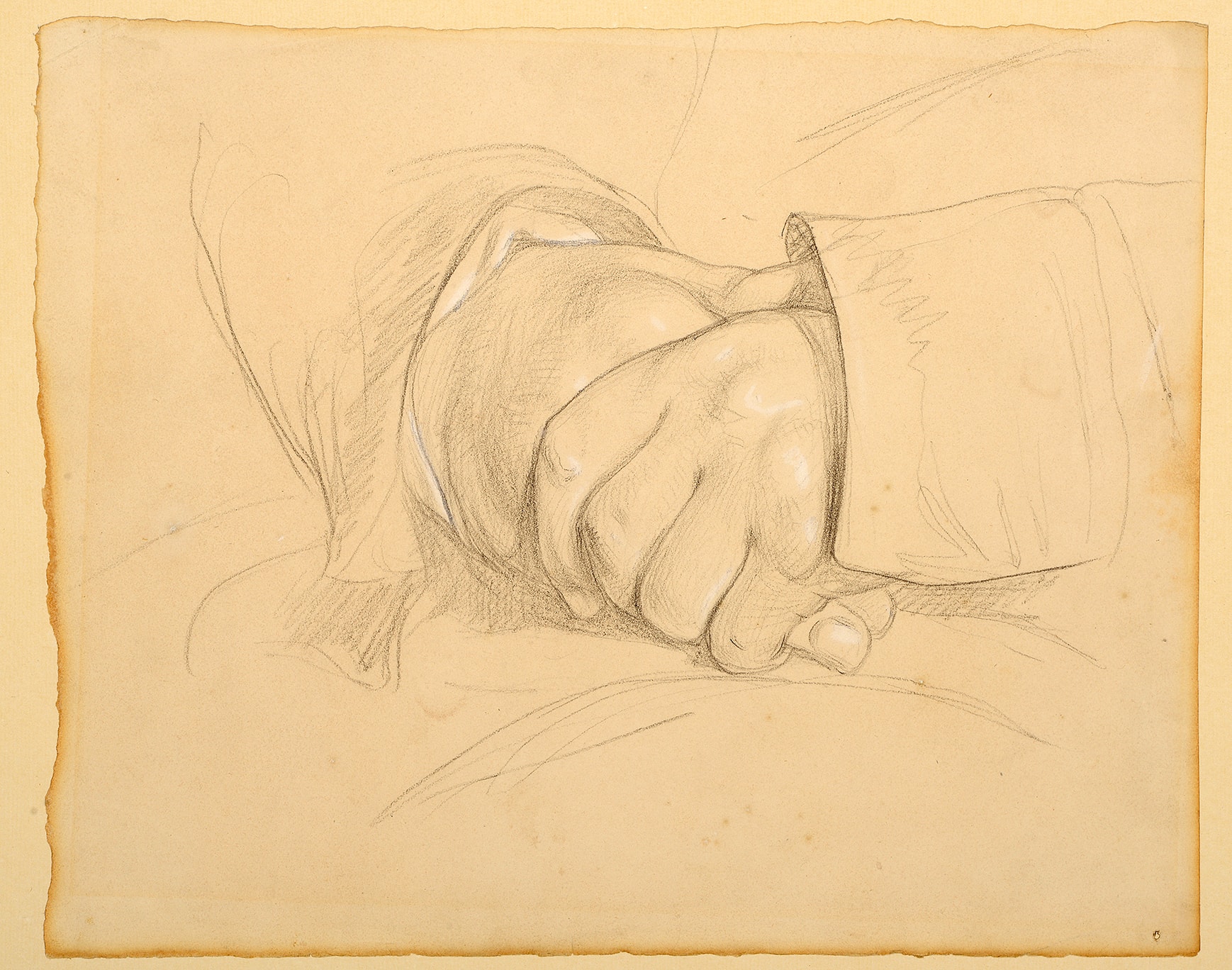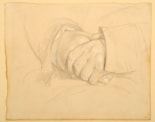Benjamin Robert HAYDON
(Plymouth 1786 - London 1846)
Study of a Man’s Clasped Hands, Said to be Those of William Wordsworth
Sold
Pencil, heightened with white chalk.
243 x 302 mm. (9 1/2 x 11 7/8 in.) [sheet]
243 x 302 mm. (9 1/2 x 11 7/8 in.) [sheet]
This drawing is said to depict the hands of a previous owner of the sheet, the English Romantic poet William Wordsworth (1770-1850). Haydon met Wordsworth around 1814 and the two became close and lifelong friends. Haydon held Wordsworth in very high regard, producing a number of portrait drawings and paintings of him, notably a drawing of 1819 in the collection of the Wordsworth Trust and a painting of Wordsworth on Helvellyn of 1842, now in the National Portrait Gallery in London. Haydon also had a life mask of the author made in 1815. As the artist recorded in his diary entry for June 13th, 1815: ‘I had a cast made yesterday of Wordsworth’s face. He bore it like a philosopher...Wordsworth was sitting in the other room in my dressing gown, with his hands folded, sedate, steady & solemn.’ The present sheet may perhaps have been drawn at this time.
The significance that Haydon placed on the hands of his sitters is seen in his desire to study and draw from Wordsworth’s hands for his portrayal of the poet in the large painting of Christ’s Entry into Jerusalem. As Haydon’s modern biographer has noted, ‘The cast would prove a useful reference for the artist when his subject was not available to it in person. When the time came, however, to put Wordsworth’s head into the painting, Haydon wrote to enquire when he would be back in town. ‘I wish to have your hands and every part as it ought to be’, he explained, ‘which one cannot do from a cast.’ Ever alert to posterity, Wordsworth wrote back to say that it so happened he had had casts made of both hands and hoped ‘the substitute may not be wholly useless.’’ The casts of Wordworth’s hands were duly delivered to Haydon.
A similar drawing of the left hand of the artist Sir David Wilkie, another close friend of Haydon’s, appeared at auction in London in 2003, while a stylistically comparable study of the arms of a woman crossed over her breast, albeit of much larger dimensions, is in the British Museum.
The significance that Haydon placed on the hands of his sitters is seen in his desire to study and draw from Wordsworth’s hands for his portrayal of the poet in the large painting of Christ’s Entry into Jerusalem. As Haydon’s modern biographer has noted, ‘The cast would prove a useful reference for the artist when his subject was not available to it in person. When the time came, however, to put Wordsworth’s head into the painting, Haydon wrote to enquire when he would be back in town. ‘I wish to have your hands and every part as it ought to be’, he explained, ‘which one cannot do from a cast.’ Ever alert to posterity, Wordsworth wrote back to say that it so happened he had had casts made of both hands and hoped ‘the substitute may not be wholly useless.’’ The casts of Wordworth’s hands were duly delivered to Haydon.
A similar drawing of the left hand of the artist Sir David Wilkie, another close friend of Haydon’s, appeared at auction in London in 2003, while a stylistically comparable study of the arms of a woman crossed over her breast, albeit of much larger dimensions, is in the British Museum.
Born in Devon, the son of a bookseller, Benjamin Robert Haydon studied under Henry Fuseli at the Royal Academy Schools in London, and was determined to make his name as a history painter. He made a comprehensive study of the fragments of the Parthenon frieze, recently brought to England by Lord Elgin in 1808, which resulted in some splendid drawings. His painting Dentatus was, however, rejected by the Royal Academy, and led to a longstanding feud between the artist and the institution. One of his few successes as a history painter was a massive canvas of Christ’s Entry into Jerusalem, exhibited in 1820 and admired by John Keats, William Hazlitt and William Wordsworth, all of whom were depicted in the painting, as well as Sir Walter Scott. Always in financial difficulties, Haydon was jailed for debt in 1823. In the early 1840s, the artist entered the competition for the decoration of the House of Commons with scenes from British history, but failed to gain a commission. Among his pupils was Edwin Landseer. In June 1846 he committed suicide, at the age of sixty. Although he saw himself as a genius, Haydon never achieved lasting success as a painter, and still remains a relatively obscure figure today. He is perhaps best known for his autobiography, published in 1853.
Haydon was an excellent draughtsman, working in pen and ink, graphite and black and white chalks on both white and tinted papers. Indeed, as one recent scholar has noted, ‘If...Haydon deserves any re-assessment of his achievements it must be primarily on account of his drawings, by far his most substantial artistic achievement and one for which he deserves to be much better known. Among them are some of the finest drawings produced by any British artist in the nineteenth century. His wide-ranging interests, his probing mind, his real understanding of outward form and inner character, his concern for physiognomy and phrenology, his desire to learn from the Old Masters and from the sculptors of antiquity, all of these can be seen and appreciated in his drawings.’
Provenance
William Wordsworth, Rydal Mount, Ambleside;
Thence by descent to his great-great-great nephew, Prof. Jonathan Wordsworth, Oxford, until 1999
His (anonymous) sale, London, Sotheby’s, 15 July 1999, lot 100
Agnew’s, London, in 2000
Bought from them in 2001 by a private collection, USA.
Exhibition
London, Thos. Agnew and Sons Ltd., English Watercolours, Drawings and Small Oil Paintings: Agnew’s 127th Annual Exhibition, 2000, no.63.




